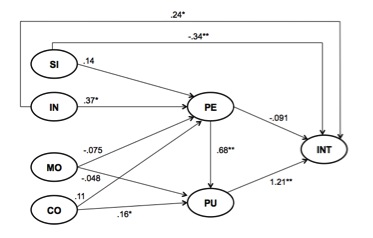Media Effects Research Lab - Research Archive
Understanding intention to use mobile time banking
Student Researcher(s)
Keith Han (Ph.D Candidate);
Rob Grace (Ph.D Candidate);
Miao Miao (Ph.D Candidate);
Faculty Supervisor
INTRODUCTION
This paper seeks to understand the factors contributing to the intention to use a mobile time banking application. Time banking is a community-based, volunteer system in which time credits are earned and spent based on offered or received assistance. Mobile time banking utilizes mobile information technology to organize and coordinate time banking activities.
RESEARCH QUESTION / HYPOTHESES:
RQ1: What factors contribute to the intention to adopt a mobile time banking application?
METHOD
A survey was conducted in order to test an extension of the Technology Adoption Model (TAM) adapted for the context of mobile time banking. The survey was administered through Amazon’s Mechanical Turk, and featured initial sections measuring demographic information and an individual’s technological affinity. Technological affinity is constituted by four constructs accounting for an individual’s amenability to the adoption of a new, socially interactive technology. These constructs are social interaction, innovativeness, mobility, and convenience. Next the participants were informed of mobile time banking and the developed mobile application through three scenarios of use as well as a short video on the functionalities of the application. Following this information, the participants responded to items measuring their intentions of adopting the technology. The data acquired through this survey was subjected to structural equation modeling and the results were discussed.
RESULTS
This paper gained understanding of the contributing influences for the adoption of a mobile time banking application. Testing the extended TAM, this paper found significant relationships between perceived usefulness and intention to use, as well as a strong positive relationship between perceived ease of use and perceived usefulness. In this regard, the results of this survey confirm the strong relationship between perceived usefulness and intention to use established in prior literature. Interestingly, the extended model tested here failed to find a significant relationship between perceived ease of use and intention to use. This may result from the participants’ unfamiliarity with the mobile time banking application.

Extended Technology Adoption Model including constructs of technological affinity
Among the constructs constituting technological affinity, innovativeness and convenience were found as significant contributors to the intention to use the technology. These results support further consideration of the implications of marketing and designing a system unfamiliar to users. A major consideration in this respect is effectively communicating system functionality and usage such that users will be more likely to perceive a system’s ease of use. The demonstrated significance of these constructs of technological affinity recommends the expansion of TAM to include such influences on technology adoption in future research.
DISCUSSION/ CONCLUSION
Overall, this paper contributes to a further understanding of mobile time banking, and extends TAM to better account for the unique context posed by individual technology adoption of mobile, socially interactive technologies. The results of this study are important for the ongoing development and design of a mobile time banking system.
For more details regarding the study contact
Dr. S. Shyam Sundar by e-mail at sss12@psu.edu or by telephone at (814) 865-2173

